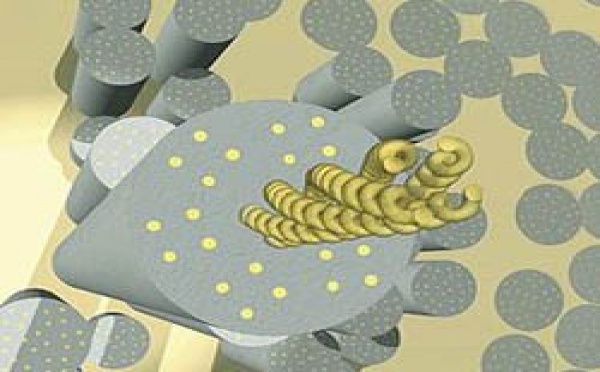Lavender, a plant which calms spirits

lavender: lavender field
Among numerous properties of lavender, the most known remains without doubt its capacity to favour relax. In fact, it acts as a balancing factor of nervous system. So it can be used in order to fight anxiety, insomnia, stress and favours a restorative sleep. Its soothing action contributes equally to counter irritability and to calm instability feeling. Being a cephalic plant, lavender result particularly efficient in case of headaches, migraines and vertigos.
For insomnia treatment, it is recommended to put two to three drops on pillow or to place at the bottom that last a lavender bunch. It is said that calming principles of plant would be activated by heat that emits head. To palliate stress, it is advised to add five to six drops of lavender essential oil in bath or to hang lavender flowers bag under tap, during your bathtub is filling. Diffused in the air, it constitutes an efficient mean to fight irritability. For people subject to headaches, a massage on temples with a few drops of lavender oil will be a great help.
Lavender can also be used by internal way, as it conserves its medicinal properties. Lavender infusion , with very agreeable aroma, remains a drink very beneficial for stressed, nervous, exhausted, irritable, depressed people who suffer from headaches and insomnia.
For insomnia treatment, it is recommended to put two to three drops on pillow or to place at the bottom that last a lavender bunch. It is said that calming principles of plant would be activated by heat that emits head. To palliate stress, it is advised to add five to six drops of lavender essential oil in bath or to hang lavender flowers bag under tap, during your bathtub is filling. Diffused in the air, it constitutes an efficient mean to fight irritability. For people subject to headaches, a massage on temples with a few drops of lavender oil will be a great help.
Lavender can also be used by internal way, as it conserves its medicinal properties. Lavender infusion , with very agreeable aroma, remains a drink very beneficial for stressed, nervous, exhausted, irritable, depressed people who suffer from headaches and insomnia.
Lavender, a plant which relieves body

lavender: lavender flower
Numerous physical pains can be relieved, even jammed thanks to lavender. It may be a great help, in particular for digestive apparatus, which has sometimes to face to cases of diarrhoeas and flatulences and gastroenteritis and nauseas and indigestions and distensions, or even, intestinal parasitic. It will have to be then consumed in infusion, one to three times a day.
Certain frequent troubles of respiratory apparatus, as cough and cold and blocked nose and fever and sinusitis and throat pains, spasms from nervous origin or even asthma can be calmed thanks to lavender and its anti-infectious action. It will act here being diffused in the air or under infusion form.
Disinfecting and cicatrizing lavender power will manifest in cases of burning and insects stings and sunburns, wounds or eczema. Added to toilet water, lavender vinegar constitutes an efficient cure to decrease acne problems. Its preparation is very simple : it is enough to macerate 100 grams of fresh lavender heads in one litre of white vinegar during eight days.
Rheumatisms which, moreover being particularly painful, can tighten and deform the smallest articulation of human skeleton, generate in certain acute pains. Relaxing and analgesic effects of essential lavender oil may attenuate pains as well as muscular aches. It will use then in bath water, in rub or in cataplasm at sensible places. For women suffering from menstrual troubles, it is good to know that lavender is an emmenagogue plant, that is to say it regulates and makes easy menstrual cycle.
Certain frequent troubles of respiratory apparatus, as cough and cold and blocked nose and fever and sinusitis and throat pains, spasms from nervous origin or even asthma can be calmed thanks to lavender and its anti-infectious action. It will act here being diffused in the air or under infusion form.
Disinfecting and cicatrizing lavender power will manifest in cases of burning and insects stings and sunburns, wounds or eczema. Added to toilet water, lavender vinegar constitutes an efficient cure to decrease acne problems. Its preparation is very simple : it is enough to macerate 100 grams of fresh lavender heads in one litre of white vinegar during eight days.
Rheumatisms which, moreover being particularly painful, can tighten and deform the smallest articulation of human skeleton, generate in certain acute pains. Relaxing and analgesic effects of essential lavender oil may attenuate pains as well as muscular aches. It will use then in bath water, in rub or in cataplasm at sensible places. For women suffering from menstrual troubles, it is good to know that lavender is an emmenagogue plant, that is to say it regulates and makes easy menstrual cycle.
A few advices to plant and maintain young lavender plants

lavender: lavender young plant
lavande officinale angustifolia adapts itself almost everywhere from the moment when we choose a variety which will know acclimate to its future welcome region. Lavender planted in a region which knows very cold winters will have to be entirely covered by ten centimetres of straw or firs branches in order to be isolated of cold and to survive to winter period. The ground must be well drained; so it has not to hesitate to add gravels and sand to a too heavy and compact ground.
Apart the regular watering necessary to roots during the first summer, lavender does not need particular watering. Nevertheless, if the absence of rains persists too much, water generously your young plants. Avoid, as much as possible, to plant other plants near your lavender. Once terminated blooming period and dried flowers, plants have to be trimmed in ball form. We generally cut all the flourished part of stem, until foliage. This cutting must occur latest at the end of August, in order to let time to the plant to cicatrize.
Lavender can equally be cultivated in pot, under the conditions that is equipped with holes for drainage and it is of right dimension. So it has to follow evolution of young plant regularly and adapt pot size gradually. Until the three first centimetres of ground are not dry, it is not necessary to water plant. As soon as temperature permits, the young plant must be put outside. Lavender needs at least of six hours of sun daily.
Apart the regular watering necessary to roots during the first summer, lavender does not need particular watering. Nevertheless, if the absence of rains persists too much, water generously your young plants. Avoid, as much as possible, to plant other plants near your lavender. Once terminated blooming period and dried flowers, plants have to be trimmed in ball form. We generally cut all the flourished part of stem, until foliage. This cutting must occur latest at the end of August, in order to let time to the plant to cicatrize.
Lavender can equally be cultivated in pot, under the conditions that is equipped with holes for drainage and it is of right dimension. So it has to follow evolution of young plant regularly and adapt pot size gradually. Until the three first centimetres of ground are not dry, it is not necessary to water plant. As soon as temperature permits, the young plant must be put outside. Lavender needs at least of six hours of sun daily.
Read in the same themes
Available suggestion publication in the same themes



















